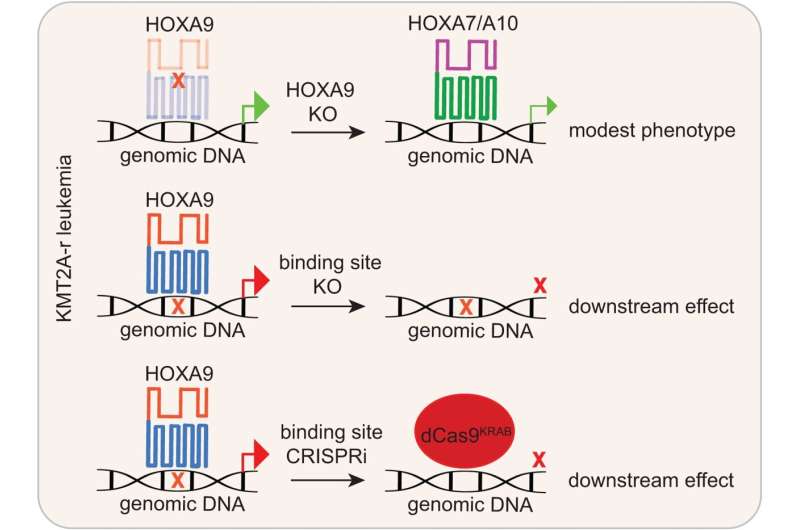This article has been reviewed according to Science X's editorial process and policies. Editors have highlighted the following attributes while ensuring the content's credibility:
fact-checked
peer-reviewed publication
trusted source
proofread
Research reveals functional targets of oncogenic HOXA9 protein in high-risk pediatric leukemia

Scientists at St. Jude Children's Research Hospital have comprehensively identified genes directly regulated by a protein associated with high-risk pediatric leukemias. High-risk leukemias, particularly MLL-rearranged (MLL-r) leukemia, often overexpress the homeodomain transcription factor HOXA9 protein, which cannot currently be targeted with drugs.
This study provides a foundation for revealing the HOXA9 regulation network and finding novel drug targets downstream of HOXA9 that can form the basis of new treatments. The findings were published today (Nov. 28) in Nature Communications.
HOXA9 is a transcription factor, a type of protein that binds DNA to regulate the expression of other genes. Overexpression of HOXA9 is a hallmark in many cancers, including high-risk leukemias, such as the MLL-r subtype. Finding the genes regulated by HOXA9 could reveal new ways to treat leukemia by undermining how the protein helps cancers grow and survive.
Due to the technical challenges of working with HOXA9, the downstream regulation network of the protein was poorly understood. The St. Jude team established a unique system to find these genes regulated by HOXA9.
"We confirmed two major known targets, FLT3 and CDK6," said corresponding author Chunliang Li, Ph.D., St. Jude Department of Tumor Cell Biology. "Both genes can be therapeutically targeted by drugs, which shows good outcomes in preclinical models with HOXA9 overexpression. Our results provided direct evidence to support the enhancer regulation of FLT3 and CDK6 through HOXA9."
In addition to these well-studied genes, the scientists found 227 other target sites bound by HOXA9. Many of those sites were located at noncoding regulatory regions, likely enhancers. They validated the top 10 candidates in cell-based experiments conducted in collaboration with computational biologists from the St. Jude Center for Applied Bioinformatics.
Several of these hits explained previous results observed using current Food and Drug Administration-approved drugs, which lends credibility to the other results from the screen and suggests they may be productive targets for novel leukemia drugs.
To perform the screen, the St. Jude group established a TetOn-inducible system to express tagged HOXA9 in MLL-r leukemia cell lines. Using this unique research tool followed with chromatin immunoprecipitation sequencing (ChIP-seq) technology, they successfully identified where in the genome HOXA9 binds DNA in MLL-r leukemic cells.
"Using state-of-the-art research tools and elegant model systems, we have a better understanding of how HOXA9 works in high-risk leukemia cells," said co-first author Shaela Fields, St. Jude Department of Tumor Cell Biology. "Now, we can start the long process to find and develop new drugs to make our patients healthier by taking advantage of that information."
Overcoming a HOXA9 family problem
While it was previously known that HOXA9 is overexpressed in high-risk pediatric leukemias, it has historically been challenging to study and target. The HOX family of proteins contains 39 members, which are all very similar to each other. The similarity also makes it challenging to study because current techniques have trouble distinguishing between the HOX proteins. Functionally, other HOX family members could potentially compensate for HOXA9 function upon targeting.
With that in mind, the researchers created a system that identified the genes bound specifically by HOXA9 in a certain leukemia subtype (mixed-lineage leukemia rearrangement or MLL-r) by inserting a tag onto HOXA9.
"Imagine you are in a dog park and need to find a certain golden retriever, but there are a bunch of them running around, and you don't know which one is yours because all the dogs look the same," said Li. "If you put a neon pink harness on your dog beforehand, it's easy to find among the group. That is how we could track everywhere HOXA9 went."
The small tag does not affect HOXA9's regular function and makes HOXA9 easy to trace in cells. The researchers then sequenced the attached DNA to identify the leukemia-related genes bound by HOXA9, allowing scientists to study this relatively small list of genes that may be amenable to therapeutic development.
"We narrowed hundreds of thousands of targets to just over two hundred by comparing to controls," said Fields. "And when we can investigate the regulation mechanism and network of HOXA9, and what's happening in the cells, that's where hopefully we can find ways to help kids with high-risk cancers get better."
More information: Shaela Wright et al, Systematic characterization of the HOXA9 downstream targets in MLL-r leukemia by noncoding CRISPR screens, Nature Communications (2023). DOI: 10.1038/s41467-023-43264-5




















